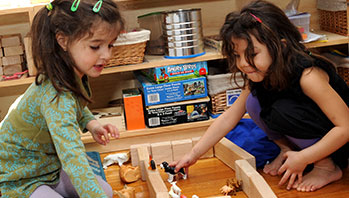- building blocks
- cardboard boxes
- flat cardboard pieces
- modeling clay
- nonfiction books about cars and parking garages
- pictures of parking garages
- toy cars
- writing and drawing materials
- above
- below
- build
- door
- in front of
- next to
- on top of
- under
MA Standards:
English Language Arts/Speaking and Listening/SL.PK.MA.5 Create representations of experiences or stories (e.g., drawings, constructions with blocks or other materials, clay models) and explain them to others.
Head Start Outcomes:
Approaches to Learning/Initiative and Curiosity Demonstrates flexibility, imagination, and inventiveness in approaching tasks and activities.
PreK Learning Guidelines:
English Language Arts/Composition 16 Use their own words or illustrations to describe their experiences, tell imaginative stories, or communicate information about a topic of interest.
Parking Garage

© Commonwealth of Massachusetts, Department of Early Education and Care (Jennifer Waddell photographer). All rights reserved.
Skill Focus: Hand-Eye Coordination, Spatial Relationships, Vocabulary
Display a group of toy cars. Show children the pictures of parking garages and discuss some differences (size, number of floors, materials) and similarities (park cars, ramps, floors, materials). Then tell children you want them to build a garage big enough to park all the cars. Ask children to think about how big or tall they will make their garage. Ask children, How many floors do you think you’ll need to fit all of these cars? Encourage children to work together to build a parking garage.
Adaptation: Challenge children with strong math skills to solve the following problem: If we had 10 more cars to fit in your garage, how many more floors do you think you will need?
